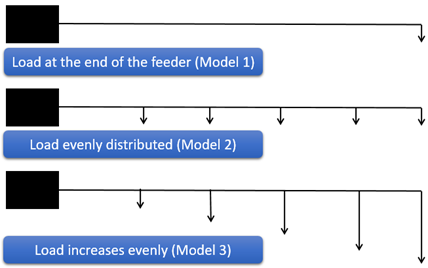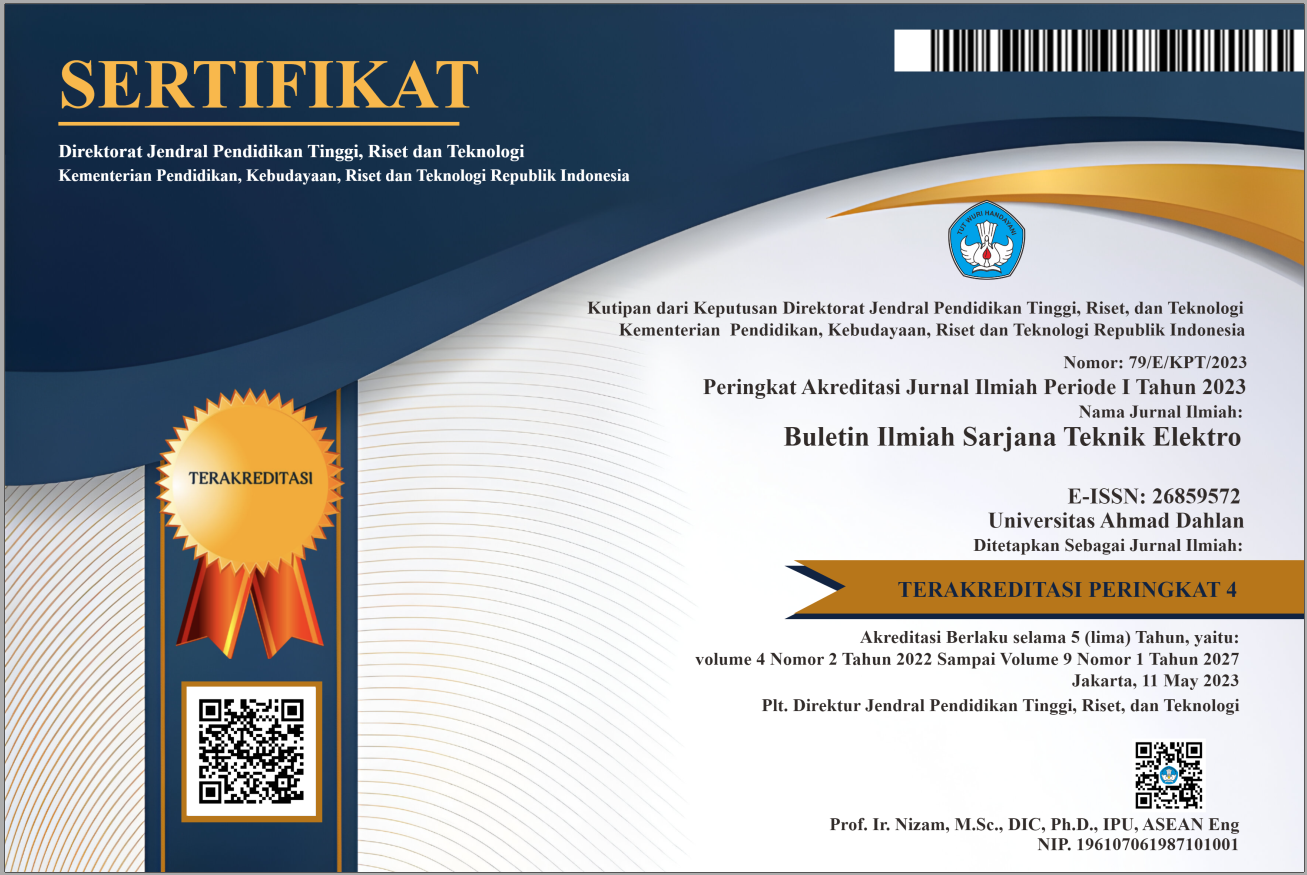A Comprehensive Simulation of PEV Penetration Impact on Residential Area Distribution Network
DOI:
https://doi.org/10.12928/biste.v5i1.7748Keywords:
Distribution Network, PEV Penetration, Voltage Drop, Feeder Loading, Private ChargingAbstract
Nowadays, rapid growth of electric vehicles is one of the breakthroughs for the future. Electrical utility with first stage of EV ecosystem adoption has to prepare for the impact of high demand of PEV penetration especially in residential area. High number of private charging points in residential area is a big future demand that needs to be considered. This study aims to create a comprehensive model of electric vehicle charging penetration impact in residential area with the worst possible conditions and specific data in Indonesia. Thus the grid operator can prepare for the future impact of the PEV charging in residential area. PEV charging profile and real residential load profile in Indonesia are recorded and used in this study. Driving behavior survey, distribution network modelling and PEV charging profile modelling are constructed. High PEV penetration feeder loading and voltage drop are evaluated. High PEV penetration would impact on overloading and voltage drop on the network. Uniformly distributed load has the highest loading 129.4%, on the other the highest voltage drop 0.87p.u. happen in the centralized load distribution model. Peak shifting in distribution network happen following the EV user charging behavior 17:45 shifted to 20:30. However, for the first stage EV ecosystem development, the time shifted strategy including varying the PEV charging location near the transformer could resulting valley filling and reducing the total network loses.
References
N. Melo, F. Mira, A. De Almeida, and J. Delgado, “Integration of PEV in Portuguese distribution grid: Analysis of harmonic current emissions in charging points,” 11th International Conference on Electrical Power Quality and Utilisation, pp. 1-6, 2011, https://doi.org/10.1109/EPQU.2011.6128893.
C. H. Dharmakeerthi, N. Mithulananthan, and T. K. Saha, “Impact of electric vehicle fast charging on power system voltage stability,” International Journal of Electrical Power & Energy Systems, vol. 57, pp. 241–249, 2014, https://doi.org/10.1016/j.ijepes.2013.12.005.
R. B. Bass and N. Zimmerman, “Impacts of Electric Vehicle Charging on Electric Power Distribution Systems,” 2013, https://doi.org/10.15760/trec.145.
K. T. Chau and C. C. Chan, “Emerging energy-efficient technologies for hybrid electric vehicles,” in Proceedings of the IEEE, vol. 95, no. 4, pp. 821–835, 2007, https://doi.org/10.1109/JPROC.2006.890114.
C. C. Chan, “The state of the art of electric, hybrid, and fuel cell vehicles,” Proceedings of the IEEE, vol. 95, no. 4, pp. 704–718, 2007, https://doi.org/10.1109/JPROC.2007.892489.
IEA, “Global EV outlook,” Internal Energy Agency, France, 2020.
W. Su and M. Y. Chow, “Investigating a large-scale PHEV/PEV parking deck in a smart grid environment,” NAPS 2011 - 43rd North Am. Power Symp., pp. 9–14, 2011, http://dx.doi.org/10.1109%2FNAPS.2011.6024842.
S. Rezaee, E. Farjah, and B. Khorramdel, “Probabilistic analysis of plug-in electric vehicles impact on electrical grid through homes and parking lots,” IEEE Trans. Sustain. Energy, vol. 4, no. 4, pp. 1024–1033, 2013, https://doi.org/10.1109/TSTE.2013.2264498.
M. Ashfaq, O. Butt, J. Selvaraj, N. Rahim, and M. Ashfaq, “Assessment of electric vehicle charging infrastructure and its impact on the electric grid : A review grid : A review,” International Journal of Green Energy, vol. 18, no. 7, pp. 657–686, 2021, https://doi.org/10.1080/15435075.2021.1875471.
H. Morais, T. Sousa, Z. Vale, and P. Faria, “Evaluation of the electric vehicle impact in the power demand curve in a smart grid environment,” Energy Conversion and Management, vol. 82, pp. 268–282, 2014, https://doi.org/10.1016/j.enconman.2014.03.032.
S. Rahman and G. B. Shrestha, “An investigation into the impact of electric vehicle load on the electric utility distribution system,” in IEEE Transactions on Power Delivery, vol. 8, no. 2, pp. 591-597, 1993, https://doi.org/10.1109/61.216865.
C. C. Onn et al., “Greenhouse gas emissions associated with electric vehicle charging : The impact of electricity generation mix in a developing country,” Transportation Research Part D: Transport and Environment, vol. 64, pp. 15-22, 2018, https://doi.org/10.1016/j.trd.2017.06.018.
C. Filote, R. -A. Felseghi, M. S. Raboaca, and I. Aşchilean, “Environmental impact assessment of green energy systems for power supply of electric vehicle charging station,” International Journal of Energy Research, vol. 44, no. 13, pp. 10471-10494, 2020, https://doi.org/10.1002/er.5678.
A. Kiani, “Electric vehicle market penetration impact on transport-energy- greenhouse gas emissions nexus : A case study of United Arab Emirates,” Journal of Cleaner Production, vol. 168, pp. 386–398, 2017, https://doi.org/10.1016/j.jclepro.2017.08.242.
Y. Saputra, M. Kim and Suwarno, “Effect of Distributed Generation on Transformer Ageing in Industrial and Residential Area with High Penetrations of Electric Vehicles (Study Case in Jakarta, Indonesia),” 2019 2nd International Conference on High Voltage Engineering and Power Systems (ICHVEPS), pp. 247-256, 2019, https://doi.org/10.1109/ICHVEPS47643.2019.9011121.
S. Shafiee, M. Fotuhi-Firuzabad and M. Rastegar, "Investigating the Impacts of Plug-in Hybrid Electric Vehicles on Power Distribution Systems," IEEE Transactions on Smart Grid, vol. 4, no. 3, pp. 1351-1360, 2013, https://doi.org/10.1109/TSG.2013.2251483.
L. P. Fernández, T. G. San Román, R. Cossent, C. M. Domingo, and P. Frías, “Assessment of the Impact of Plug-in Electric Vehicles on Distribution Networks,” in IEEE Transactions on Power Systems, vol. 26, no. 1, pp. 206-213, 2011, https://doi.org/10.1109/TPWRS.2010.2049133.
Z. Darabi and M. Ferdowsi, “Impact of Plug-In Hybrid Electric Vehicles on Electricity Demand Profile,” Smart Power Grids 2011, vol. 53, no. 4, pp. 319–349, 2012, https://doi.org/10.1007/978-3-642-21578-0_11.
A. G. Boulanger, A. C. Chu, S. Maxx and D. L. Waltz, “Vehicle Electrification: Status and Issues,” in Proceedings of the IEEE, vol. 99, no. 6, pp. 1116-1138, 2011, https://doi.org/10.1109/JPROC.2011.2112750.
K. Clement-Nyns, E. Haesen and J. Driesen, “The Impact of Charging Plug-In Hybrid Electric Vehicles on a Residential Distribution Grid,” in IEEE Transactions on Power Systems, vol. 25, no. 1, pp. 371-380, 2010, https://doi.org/10.1109/TPWRS.2009.2036481.
R. C. Green, L. Wang, and M. Alam, “The impact of plug-in hybrid electric vehicles on distribution networks: A review and outlook,” Renewable and Sustainable Energy Reviews, vol. 15, no. 1, pp. 544–553, 2011, https://doi.org/10.1016/j.rser.2010.08.015.
T. Gonen, “Electric Power Distribution System Engineering,” Sacramento: McGraw-Hill, Inc, 1986.
K. G. H. Mangunkusumo, K. L. Lian, P. Aditya, Y. -R. Chang, Y. D. Lee, Y. H. Ho “A Battery Management System for a Small Microgrid System,” 2014 International Conference on Intelligent Green Building and Smart Grid (IGBSG), pp. 1-6, 2014, https://doi.org/10.1109/IGBSG.2014.6835277.
L. Wen and C. Ning, “Experiments study on charge technology of lead-acid vehicle batteries,” Journal of Beijing Institute of Technology, vol. 17, no. 2, pp. 159-163, 2008, http://journal.bit.edu.cn/jbit/en/article/id/20080207.
S. Li, C. Zhang and S. Xie, "Research on Fast Charge Method for Lead-Acid Electric Vehicle Batteries," 2009 International Workshop on Intelligent Systems and Applications, pp. 1-5, 2009, https://doi.org/10.1109/IWISA.2009.5073068.
B. Sun, X. Tan, and D. H. K. Tsang, “Optimal Charging Operation of Battery Swapping and Charging Stations with QoS Guarantee,” IEEE Transactions on Smart Grid, vol. 9, no. 5, pp. 4689–4701, 2018, https://doi.org/10.1109/TSG.2017.2666815.

Published
How to Cite
Issue
Section
License
Copyright (c) 2023 Kevin Gausultan Hadith Mangunkusumo, Joko Hartono

This work is licensed under a Creative Commons Attribution-ShareAlike 4.0 International License.
Authors who publish with this journal agree to the following terms:
- Authors retain copyright and grant the journal right of first publication with the work simultaneously licensed under a Creative Commons Attribution License that allows others to share the work with an acknowledgment of the work's authorship and initial publication in this journal.
- Authors are able to enter into separate, additional contractual arrangements for the non-exclusive distribution of the journal's published version of the work (e.g., post it to an institutional repository or publish it in a book), with an acknowledgment of its initial publication in this journal.
- Authors are permitted and encouraged to post their work online (e.g., in institutional repositories or on their website) prior to and during the submission process, as it can lead to productive exchanges, as well as earlier and greater citation of published work (See The Effect of Open Access).
This journal is licensed under a Creative Commons Attribution-ShareAlike 4.0 International License.


